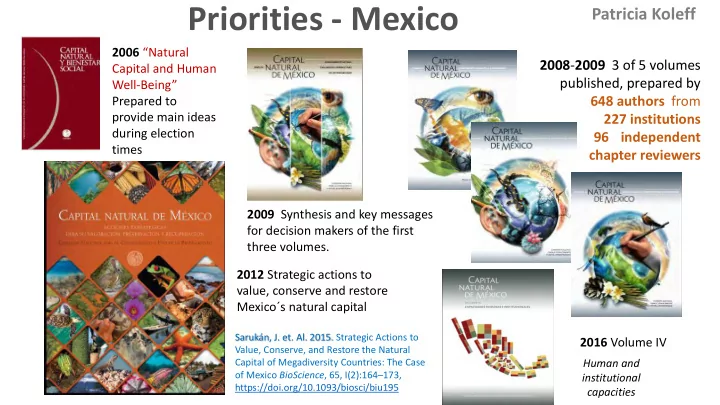

Priorities - Mexico Patricia Koleff 2006 “Natural 2008 - 2009 3 of 5 volumes Capital and Human published, prepared by Well- Being” Prepared to 648 authors from provide main ideas 227 institutions during election 96 independent times chapter reviewers 2009 Synthesis and key messages for decision makers of the first three volumes. 2012 Strategic actions to value, conserve and restore Mexico´s natural capital Sarukán, J. et. Al. 2015. Strategic Actions to 2016 Volume IV Value, Conserve, and Restore the Natural Capital of Megadiversity Countries: The Case Human and of Mexico BioScience , 65, I(2):164 – 173, institutional https://doi.org/10.1093/biosci/biu195 capacities
Patricia Koleff Priorities - Mexico • Some of the largest knowledge gaps in biodiversity relate to large and taxonomically complex groups with few (or no) specialists, including many invertebrates, fungi, algae, microorganisms, and marine life in general • acute need for monitoring populations, at least in the major groups of vertebrates. This can be achieved by creating or supporting citizen science platforms that observe careful quality assurance and control procedures, along with local capacitation programs • developing satellite-based operational systems calibrated with in situ data to obtain, process, analyze, and distribute data on the health of and changes in key ecosystems. • Applied research on different aspects of genetic diversity (species conservation and recovery programs, invasive species) and increase applied research for the management of genetic resources in the case of the cultivated plants that originated in Mexico Sarukán, J. et. Al. 2015. Strategic Actions to Value, Conserve, and Restore Regional Bio-Bridge Initiative Round Table for Latin America and the Caribbean the Natural Capital of Megadiversity Countries: The Case of Mexico 27-29 November 2017 - Bogota, Colombia BioScience , 65, I(2):164 – 173, https://doi.org/10.1093/biosci/biu195
Patricia Koleff Priorities - Mexico • Environmental restoration, in which the large gaps remain disproportionate to the need of recovering degraded ecosystems. Among the main tasks ahead are to establish formal professional education programs, to consolidate research lines, and to promote the formation of highly qualified human resources • Research on community resource management has often proved that traditional and communal management practices could significantly contribute toward a model of sustainable development. • Develop a program of sustainable food production without further deteriorating the natural capital and, to the extent that is possible, promoting the restoration of degraded areas in which unsustainable productive activities have been conducted • Innovation in technology: Robotics to deal with invasive species Sarukán, J. et. Al. 2015. Strategic Actions to Value, Conserve, and Restore Regional Bio-Bridge Initiative Round Table for Latin America and the Caribbean the Natural Capital of Megadiversity Countries: The Case of Mexico 27-29 November 2017 - Bogota, Colombia BioScience , 65, I(2):164 – 173, https://doi.org/10.1093/biosci/biu195
Recommend
More recommend